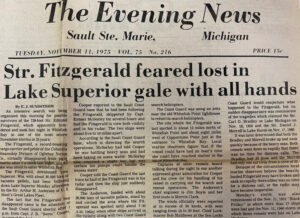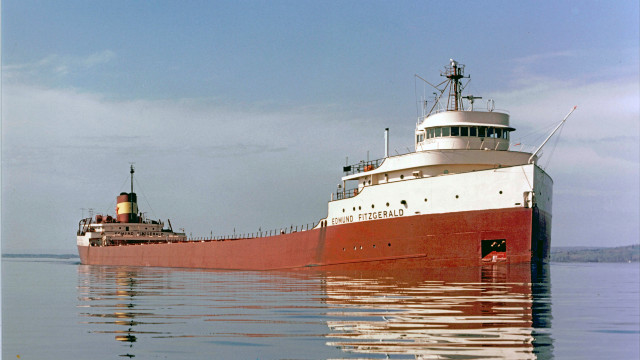By Sterling McGinn
November 10, 1975 is the date of one of the most devastating maritime tragedies on the Great Lakes: The wreck of the Edmund Fitzgerald.
The 729-foot ore carrier sank 17 miles north-northwest of Whitefish Point during a fierce Lake Superior storm. All 29 on board were lost. And this year marks the 50th anniversary.
Next Monday evening, the ship’s bell will toll its unforgettable sound in remembrance of the 29 crew members who lost their life on that stormy evening. A 30th ring remembers all who have lost their lives on the Great Lakes.
To honor the lives of the men who died aboard the Edmund Fitzgerald, the Great Lake Shipwreck Historical Society will hold two separate ceremonies on Monday, November 10.
In respect for the family of the members of the Edmund Fitzgerald, the traditional evening memorial is again closed to the public.
The Great Lakes Shipwreck Historical Society will hold a public ceremony at 2 p.m. on Monday, November 10 at Whitefish Point.
The free public event will take place outside on the grounds of the Whitefish Point Lighthouse.
Due to November’s unpredictable weather, there will be no tents or chairs available to the public for safety reasons. Limited parking will be available.
The public is asked to leave the grounds by 5 p.m. that evening so family members can attend the private 7 p.m. ceremony. “Under no circumstances will the evening ceremony for the family members of the Edmund Fitzgerald be open to the public,” the society announced.
The S.S. Edmund Fitzgerald was launched at River Rouge on June 8, 1958. The ship was owned by and named after the chairman of the board and president of Northwestern Mutual Life Insurance. At that time, she was the largest on the Great Lakes. The Fitzgerald was operated by Oglebay Norton as part of the Columbia Transportation Fleet.
The Fitzgerald carried taconite pellets – destined for steel mills – across the Great Lakes. On her final journey, the ship carried 26,116 tons of taconite pellets from Superior, Wisconsin, headed to Zug Island, near Detroit. The Fitzgerald left Superior, Wisconsin on November 9 under the command of Ernest M. McSorley. McSorley was one of the most seasoned captains on the Great Lakes.
The S.S. Arthur M. Anderson, under the command of J. B. Bernie Cooper, was trailing the Fitzgerald.
The forecast called for a storm on November 10.
On that day, the Fitzgerald reported trouble to the Anderson, noting a starboard list, two missing vent covers, and a downed fence railing. The ship was taking on water, but Captain McSorley thought his pumps could handle the situation.
During the storm, with waves 18 to 30 feet high, the Edmund Fitzgerald’s radars were disabled.
The winds had also knocked out power at the Whitefish Point Lighthouse, killing power to the light and the tower’s radio direction beacon. A backup generator failed to turn on.
The big ship was essentially sailing blind in a horrific storm.
Sometime after 7 p.m. on November 10, the Fitzgerald disappeared.
The U.S. Coast Guard executed a search. The Anderson and the S.S. William Clay Ford, anchored in Whitefish Bay, returned into the storm to assist in the search. No bodies were found. Only debris. Four days later, the wreck site was located.
Though the news of the devastating wreck did not surface in the 1975 Newberry News, Eugene, “Shine” Sundstrom, a Newberry native and Marine Editor of the Sault Evening News, covered the event. When made “Marine Man of the Year” in 1977, his coverage of the Edmund Fitzgerald sinking was considered a journalism masterpiece.
The Tuesday, November 11, 1975, issue of the Sault Evening News headlined, “Str. Fitzgerald feared lost in Lake Superior gale with all hands.”
Sundstrom’s article stated, “An intensive search was being organized this morning for possible survivors of the 729-foot Str. Edmund Fitzgerald, which apparently sank last night in Whitefish Bay in one of the most severe November storms in 35 years.”
The wreck of the Edmund Fitzgerald is considered one of the most mysterious and controversial shipwrecks on the Great Lakes.
A Coast Guard investigation concluded that the ship sank because of an ineffective hatch cover, which allowed massive flooding in the cargo hold.
The Lake Carriers Association and many Great Lakes captains disagreed with the finding of the Coast Guard. They believed that the Fitzgerald passed over the treacherous Six Fathom Shoal and “bottomed out.”
Fifty years later, the wreck is still a mystery.
At the request of family members of the crew of the ship, the Great Lakes Shipwreck Historical Society recovered the 200-pound bronze bell from the wreck site on July 4, 1995, for a memorial. It is now the centerpiece of the Great Lakes Shipwreck Museum at Whitefish Point. A replica of the bell with the names of the 29 men engraved into it was returned to the site.
For many years, the November 10 ceremony was open to both the public and family. When the COVID-19 pandemic began, the ceremony was only open to family. At the request of the family, the society agreed to allow only family to attend in person inside the Great Lakes Shipwreck Museum. Since that time, the event has been live-streamed to allow everyone to view the ceremony, which includes guest speakers and the ringing of the bell.
The family-only event, which will be live-streamed, will be available to view at the Whitefish Township Community Center at 7 p.m.
To view from home, visit the Great Lakes Shipwreck Historical Society website at shipwreckmuseum.com to find the live-stream link.











